"I want to tell you that your fact sheet on the [Missile Technology Control Regime] is very well done and useful for me when I have to speak on MTCR issues."
Is the NPT Still Viable? An Interview With Three Diplomats Working to Keep It Alive
April 2025
Since coming into force a half-century ago, the nuclear Nonproliferation Treaty (NPT) has been the central pillar of the international arms control regime and specifically, efforts to prevent the spread of nuclear weapons. Its 191 member states are divided into two groups—the five nuclear-weapons states known as the P5 (China, France, Russia, the United Kingdom and the United States) and all the rest, who pledged never to acquire such weapons. The latter group has been promised access to peaceful uses of nuclear energy (such as power and medical uses) in return for forsaking nuclear weapons; the nuclear-weapon states have committed to pursue complete disarmament. The non-nuclear weapon states have not gotten the peaceful energy benefits they expected, and disarmament has halted. Meanwhile, the NPT has become increasingly embattled as the full-scale Russian war on Ukraine has exacerbated geopolitical tensions, other treaties collapsed, Iran and North Korea keep advancing their nuclear programs, and several other states threaten to start their own programs. It is a difficult environment ahead of the 2026 NPT Review Conference when member states will take stock of the treaty and attempt to shore it up and nudge it forward. Recent conferences have failed to agree on consensus outcome documents. The last of three meetings to prepare for the 2026 event will be April 25-May 9. To explore what the 2026 Review Conference could achieve and how this year’s preparatory committee (PrepCom) meeting could be useful, Carol Giacomo, chief editor of Arms Control Today, and Shizuka Kuramitsu, a researcher with the Arms Control Association, interviewed Ambassador Harold Agyeman of Ghana, the chair of this year’s PrepCom meeting; Deputy Foreign Minister Akan Rakhmetullin of Kazakhstan, the 2024 chair; and Ambassador Jarmo Viinanen of Finland, the 2023 chair. This transcript has been edited for space and clarity.
Arms Control Today: The nuclear Nonproliferation Treaty is more than 50 years old. Is it still fit for the purpose for which it was created, or is it too battered?
Ambassador Harold Agyeman: There’s no doubt that the world is in a very difficult place. There are a lot of uncertainties across different parts of the world, and it portends very severe risks for all of us, especially when you take into account that the driving force relates to some of the P5 states. Nonetheless, I think that the NPT has stood its ground as a stabilizer in avoiding proliferation for all these decades. It has held back the proliferation rates that, at the time it was negotiated, the threat was very real. I think the fact that it’s held as a stabilizing force in avoiding proliferation is a major achievement.
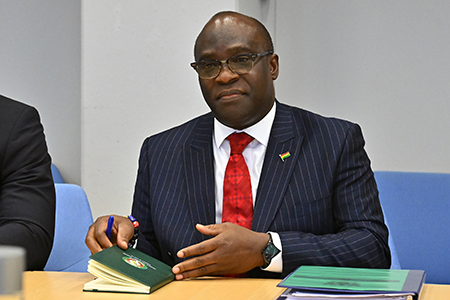
Certainly, the NPT is under pressure because the aspirations that many of our states-parties held—especially at the time of the review and extension conference in 1995, that there would be a stronger commitment to disarmament—has not necessarily panned out. That is something that we need to look at and find a resolution for. Also, the issues relating to the inalienable rights of non-nuclear-weapon states, especially for the peaceful use of nuclear energy and other applications, needs to be stepped up because this is the other end of the bargain that many have committed to.
The NPT is indeed fit for purpose, and if we were to negotiate it today, it would be very difficult to have such an agreement. We need to make very good use of the NPT to ensure that the arrangement that it was intended to provide in terms of disarmament of our nuclear weapons, the nonproliferation regime, and the peaceful use of nuclear energy, are reinforced and implemented accordingly.
Ambassador Jarmo Viinanen: The treaty is still fit for purpose. There are a lot of pressures on the treaty, from outside the treaty’s realm, but also from the inside. Yet, we have to remember that the treaty is functioning well every day. We have for example the IAEA [International Atomic Energy Agency] safeguards in place, which actually curb proliferation risks all the time, every day, everywhere. We have a very elaborate system for promoting the peaceful uses of nuclear energy for development to combat climate change, and so on. We certainly need to do better in that respect.
Another issue concerning nuclear disarmament: This is the only treaty where the recognized nuclear-weapon states have agreed to a legal obligation to engage in good faith in nuclear disarmament. Without that, there wouldn’t be a legal commitment or obligation from their side. At the same time, when we are approaching the review conference next year, we can see that the turmoil that we are facing in today’s world actually makes all the purposes of the treaty even more urgent and important. It is clear that in this very difficult situation, we need more nuclear disarmament than ever before. It has become obvious with the Russian war in Ukraine and with the nuclear threats that have followed throughout the war.
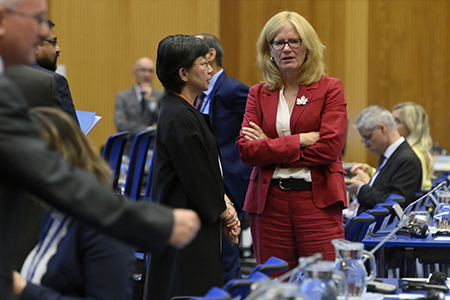
It means that something concrete has to happen in this respect. It’s not going to be enough that the nuclear-weapon states say that the international environment is not conducive to nuclear disarmament. They are the states-parties that have the most leverage, they are permanent members in the UN Security Council. They can do better and they must do better. At the same time, concerning proliferation, we can see even during the last two to three weeks in multiple places where there is serious discussion about acquiring nuclear weapons, in states-parties that never had nuclear weapons before but now are contemplating seriously whether they should take that path. This should be a wake-up call for all of us to do everything to curb the tendencies that lead to nuclear proliferation because we don’t need any more states with nuclear weapons in this world.
The third issue is on the peaceful uses side. As with proliferation and nuclear disarmament, we can see that climate change is advancing at a very rapid pace. We see serious catastrophes happening in different parts of the world, and they are partly due to climate change. Nuclear energy, used in a peaceful manner, can actually be helpful in combatting climate change and advancing development, so we need to do better in that respect.
Deputy Foreign Minister Akan Rakhmetullin: The NPT is the only legal instrument where officially recognized nuclear powers have taken responsibilities to move forward the issues of disarmament and nonproliferation. Of course, the treaty is burdened by the overall political context—be it Ukraine, overall global developments, lack of mutual trust. If I may compare it with my recent presidency over the third meeting of states-parties to the TPNW [Treaty on the Prohibition of Nuclear Weapons] in New York, the TPNW is comprised of like-minded countries, non-nuclear-weapon states, that are united and they discuss different issues, like universalization, the impact on affected communities, on individuals, on the environment.
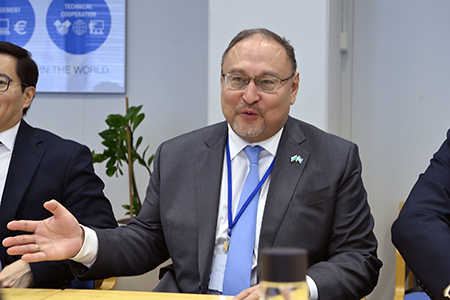
In the context of the NPT, it is very optimistic for us that the nuclear powers remain NPT states-parties, and not one of them has said the treaty is no longer relevant—that it is not fit for purpose and that we have to abandon it and go somewhere else. They are present in the NPT and they speak. They don’t agree with each other all the time, but they talk, and they do listen to each other. In some instances, they agree; in some they do not. But this treaty is the only treaty which remains relevant in terms of the global nonproliferation regime.
There are seminal issues within the treaty which are most controversial. The pillar on peaceful uses of nuclear energy remains least controversial and where we can think about areas that unite [and] converge the vision of the different states-parties, including nuclear and non-nuclear-weapon states. We also very much rely on the authority and the talking ability of non-nuclear actors to somehow try to influence the nuclear powers. What I brought away from chairing the second NPT PrepCom last year in Geneva is that we still have some domains where it is really very difficult for countries to converge their positions. Countries all agree on the relevance and the importance of each component of the treaty, but they have their own vision of how this or that component should be implemented.
I think at the 2026 Review Conference we have to at least reconfirm our commitments, which we attained during the previous review conferences. Given the political context [and] geopolitical developments, it is really very hard to build trust.… But again, just to confirm what my colleagues said, this treaty is relevant, and it is fit for purpose.
ACT: What should NPT states-parties do to achieve success at the 2026 NPT Review Conference? What specific steps must states-parties undertake to fulfill their NPT obligations and improve the atmosphere?
Rakhmetullin: It’s really a million-dollar question, and it’s really hard to answer that because they all come to the review conference or the PrepCom with their prepared national positions and national statements. We always think we’re being strong proponents of multilateralism but all these negotiations are a two-way avenue, because if we want to take something, we have to give something. I think during the preparatory period to the review conference, it is good to know each country’s redlines. They’re actually well known, and I don’t think they will shift away from their redlines. But we hope they can demonstrate a certain degree of flexibility in order to attain some tangible progress.
We can just reconfirm the existing commitments within the review conferences of 1995, 2000, and the latest, 2010, because having no result in the conference is also a result on its own because countries at least sat together, they have discussed complex issues, they again indicated their concerns, their priorities. [Although some alternative approaches were initially considered ahead of the 2024 PrepCom] we decided just to go with the existing practice, and to understand what each country is ready to take and what it’s not. Unfortunately, countries were not flexible enough and we could not arrive at a consensus, but we managed to at least produce a factual summary which served as a more procedural outcome. We just managed—sometimes by playing with different language, like adding a footnote to the document—to bring it to a situation where the countries did not oppose having some kind of final document. My strong conviction is that states-parties have to produce some kind of reflections [from the preparatory committees], because having nothing from the deliberations is just the way to nowhere.
Viinanen: The questions are very complicated. What everybody can do is adhere to what has been agreed earlier within the NPT. If we all would live up to the standards which are laid out, for example, in the UN Charter, the world would be a much better place and it would be much easier to agree on these things. But I think it’s very important that there’s a strong commitment in every state-party that we need to get an outcome from the review conference
next year.
We have had two review cycles without any outcome, and although that’s not the measurement of the success of the treaty or whether the treaty is fit for purpose, if we have this kind of diplomatic exercise—three PrepComs, a Review Conference of four weeks—that’s a lot of effort, it’s a lot of time, it’s a lot of money. We need to come out with an outcome because if we are not trying to succeed in that, it might be detrimental for the credibility of the treaty. So, this is the main issue. And as Akan said, when we come together, everybody has to compromise on certain things; otherwise, it’s not going to happen.
Another issue is political leadership. Some of our colleagues have been dealing for a very long time with these issues, and they know every detail in the whole process. Sometimes we need to have a little bit more political engagement in our capitals, because sometimes it would be a little bit easier for political leaders to overcome the challenges which sometimes are overwhelming for us diplomats to do. So, I would like to see the capital involvement on a political level.
As for possible outcomes, we cannot achieve miracles, but of course there has to be a recommitment, stronger language concerning the need to address nuclear disarmament. Here I would once again challenge our friends and colleagues in the nuclear-weapon states: Listen to the concerns of the other countries which are not in possession of nuclear weapons. Listen to the concerns which came from the TPNW meeting. Even though you don’t agree on the substance, you have to see that the concern of the majority of the states-parties to the TPNW is a real one, and it has to be addressed.
The same applies to nuclear proliferation. I don’t think that nuclear proliferation would be in any state-party’s interest. We have to be clear on this. We don’t need to have all countries possessing nuclear weapons. It would be detrimental for everybody.
Agyeman: I think that the expectation is that we should have an outcome [document] and the process for the NPT review cycle is such that it requires consensus. It will require all of us to give and take and to show flexibility during the negotiation of the final outcome document in 2026. This is a difficult task, but it’s important that we do so for some of the reasons that we have mentioned. Indeed, as a chair, it is not my intention that our ambition should exceed that of the states-parties. At the same time, I’m very conscious of the fact that there’s a strong expectation from many people around the world to have a pathway ultimately set out toward denuclearization and disarmament of nuclear-weapon states. We cannot afford to have a RevCon [Review Conference] that does not come out with an outcome document. I think that flexibility is therefore required.
One issue that Ambassador Viinanen spoke about relates to the engagement of the nuclear-weapon states themselves, because it’s important that they also engage strongly…. I’m encouraged by some of the remarks that I’ve heard from the new leader of the United States in the direction of engagement. I think it’s important that that engagement takes place, and that trust be rebuilt, in ways that can ensure that there is a cooling down of the nuclear rhetoric. It could also help to ensure that the concerns that are coming up in terms of countries that are now beginning to think about acquiring nuclear weapons, in terms of the proliferation race, can be addressed.
At the same time, there is a strong pressure from many parts of the world, including from non-nuclear-weapon states, that there should be a recommitment to the existing obligations that advances the disarmament regime. The clarity that is required is to say that proliferation is prohibited and that clarity is needed to be expressed at the RevCon in 2026. The issues relating to the peaceful uses of nuclear energy need to be practicalized so that many non-nuclear-weapon states will see a benefit from being part of this treaty.
ACT: Ambassador Agyeman, can you be more specific about the encouraging things that you heard from U.S. President Donald Trump? Are you reacting to his public remarks or has he said something specific to you?
Agyeman: I’m referring to his general remarks, which for me is encouraging. As Ambassador Viinanen indicated, there is a need for high-level political leadership to ensure that the risk is brought down. And [Trump’s] indication of a willingness to be able to engage in that direction is one that I find encouraging. I hope that we can leverage that to engage in discussions, including on the suspension of the New Strategic Arms Reduction Treaty by the Russian Federation, and look beyond 2026 in terms of what will be done by these two major nuclear-weapon states.
ACT: There have been several references today to concerns about other states possibly going nuclear. Other than Iran, what states are you talking about?
Viinanen: Iran is a very specific case. There have been long-term oversight issues with the Iranian nuclear program, dating back before 2000. It doesn’t look like Iran has made a decision to acquire a nuclear weapon. They want to keep it on a certain level. But it’s an issue which needs to be solved. And the key in solving the matter, the trust issue, is the Iranian government itself. It has to come to terms with the IAEA regulations, IAEA demands, and actually respond to them in a credible way so that we can put this issue aside.
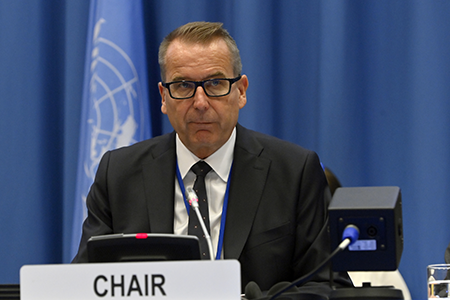 The more current issues are related to changes in U.S. policy, which have raised the issue in some countries of whether they can rely on U.S. extended nuclear deterrence. This shows that extended deterrence, whether you like it or not, has been a very effective way of exercising nonproliferation. When there is extended deterrence, there’s no need for many countries to acquire nuclear weapons themselves.
The more current issues are related to changes in U.S. policy, which have raised the issue in some countries of whether they can rely on U.S. extended nuclear deterrence. This shows that extended deterrence, whether you like it or not, has been a very effective way of exercising nonproliferation. When there is extended deterrence, there’s no need for many countries to acquire nuclear weapons themselves.
We are a long way from changes in this respect. But even serious political talk about the matter in some countries already should be a concern enough that something needs to be done. And I hope this can be solved in a way that there’s not going to be countries under the umbrella of extended deterrence who see a need to change their policy. It depends on all of the countries in that alliance or those alliances and partnerships.
ACT: Does this concern relate to NATO and France’s talks with other Europeans about possibly extending its nuclear deterrence to them?
Viinanen: I mean all of these are ripples of the same political effect, the political turmoil which we are seeing. There are a little bit different origins for each of them, but it’s part of the same issue, concern about the reliability of the extended deterrence, the security framework which had been existing in Europe for more than 75 years. But the issue when it comes to NPT is the cascading effect. If there is going to be one other country acquiring nuclear weapons, it could be easily said that there would be a second one, a third one, a fourth one. Then, the proliferation is much more difficult to contain, and therefore, there shouldn’t be any more countries acquiring nuclear weapons.
Rakhmetullin: On one hand, it’s a matter of internal policy, of the sovereign right of any country that is eligible to ensure its security by different means. At the same time, we are a bit concerned with this rhetoric in general and that this proposal is not fully understood, particularly the underlying reasons behind it, why it happened, and why France proposed that. But at the same time—I’m talking from my personal capacity as the nation of Kazakhstan—we’re a bit concerned when countries go that far.… The NPT clearly speaks about five countries which are eligible to legally have the right to possess the nuclear weapon. Going beyond that undermines the letter and spirit of the treaty.
I had numerous meetings with our French colleagues, and we know that nuclear deterrence is part of their national security doctrine. At the same time, it shouldn’t be done at the expense of the existing fragile balance. I think a similar reaction would follow any kind of rhetoric from the other side, because we have already seen that different countries were not happy with this idea, including saber-rattling rhetoric and plans to deploy more nuclear weapons or to reconsider the nuclear sharing policy.
Agyeman: The question that you pose is not an easy one, and it relates to issues largely out of the NPT but impacting the NPT strongly. From my perspective, nuclear deterrence, nuclear sharing, nuclear umbrella—all these are being redefined. We need to be very careful about the manner we go in those directions and avoid a situation where we could escalate the nuclear rhetoric and lead to a new arms race.
There needs to be a frank and robust discussion among the P5 nuclear-weapon states and for clarity to be established that it will not be in their interest—nor in any of us outside of the P5 interest—if that situation is made to unbound itself and lose control of the situation in terms of the proliferation risk that my colleagues have talked about. That for me is a major concern, especially with the unfolding situation that we are witnessing—because once one has it, another will seek it. And there will be no end to the risk. Even for the five nuclear-weapon states that are recognized under the treaty, it is difficult to ensure synchrony of actions lately.
ACT: The Russian war on Ukraine has complicated international relations for several years. You all stress the need to make progress at this next NPT Review Conference. How will you mitigate the disruption that the war is causing?
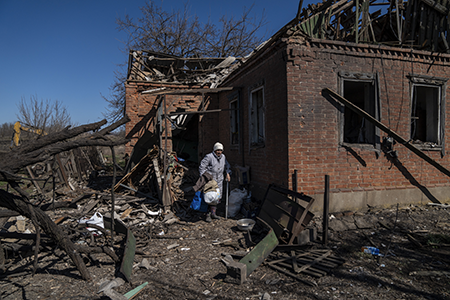 Agyeman: The situation in Ukraine today is not at the same place it was in 2022. And so, we have a bit of room to work around in a way that Ukraine does not become a negative element in the efforts to achieve consensus. Issues relating to nuclear safety and security in terms of the Ukrainian civilian nuclear infrastructure continue to be of concern but there is a bit of engagement by the IAEA director-general and his team to ensure that that risk is largely mitigated. Also, when we take the efforts that the new U.S. administration is making for peace in Ukraine, I anticipate that if the trajectory that we see is sustained, then by 2026 it will not be the big concern that should impede common agreement. But these are of course things that one cannot have full control over, because it’s not yet been resolved.
Agyeman: The situation in Ukraine today is not at the same place it was in 2022. And so, we have a bit of room to work around in a way that Ukraine does not become a negative element in the efforts to achieve consensus. Issues relating to nuclear safety and security in terms of the Ukrainian civilian nuclear infrastructure continue to be of concern but there is a bit of engagement by the IAEA director-general and his team to ensure that that risk is largely mitigated. Also, when we take the efforts that the new U.S. administration is making for peace in Ukraine, I anticipate that if the trajectory that we see is sustained, then by 2026 it will not be the big concern that should impede common agreement. But these are of course things that one cannot have full control over, because it’s not yet been resolved.
Rakhmetullin: We are trying to be optimistic about the progress we make with this because we know that today, President Trump’s talks with the [Russian] president are ongoing. That gives us a hint of feeling that the bloodshed and the conflict may deescalate from its active phase. At the same time, I’m not sure that Russia will withdraw its presence from the Zaporizhzhia nuclear plant. I think the Ukrainians, after three-plus years of conflict, will also have so many wounds—moral, financial, military, emotional—that they will not let go easily. I think they will be using this opportunity during the 2025 PrepCom, being present in the same room with Russians and with other pro-Ukrainians stakeholders, to promote their own interest, which is opposing the interests of Russia. This may impede progress. In this case, we would need to appeal to the political wisdom of some other states, which have their own vision and have their good contacts with the Ukrainian colleagues and with Russians, to try to mitigate the overall conflict and the overall negative sentiment in the room.
Iran also keeps us quite optimistic that they’re not leaving the treaty. They are there, they are quite loud, they try to promote their own interests, their priorities are to protect them, try to find some kind of positive outcome. Maybe they are not as flexible as many countries want to see them be, but at the same time it gives us a feeling of optimism that they are at least engaged in the process, they are not leaving the room and they are trying to somehow contribute to the review process.
Viinanen: As Harold said, we are in a different situation with the Russian war in Ukraine than in the summer of 2022. Probably in the spring of 2026 we are going to be even in a more different situation. So, we don’t know how that is going to look like next year.
